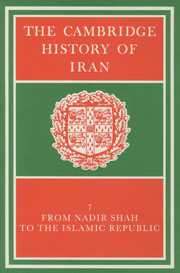Book contents
- Frontmatter
- PART 1 THE POLITICAL FRAMEWORK, 1722–1979
- PART 2 FOREIGN RELATIONS
- 8 IRANIAN RELATIONS WITH THE OTTOMAN EMPIRE IN THE EIGHTEENTH AND NINETEENTH CENTURIES
- 9 IRANIAN RELATIONS WITH RUSSIA AND THE SOVIET UNION, TO 1921
- 10 IRANIAN RELATIONS WITH THE EUROPEAN TRADING COMPANIES, TO 1798
- 11 IRANIAN RELATIONS WITH GREAT BRITAIN AND BRITISH INDIA, 1798–1921
- 12 IRANIAN FOREIGN POLICY, 1921–1979
- PART 3 ECONOMIC AND SOCIAL DEVELOPMENTS
- PART 4 RELIGIOUS AND CULTURAL LIFE, 1721–1979
- Genealogical tables
- Bibliographies
- Index
- References
10 - IRANIAN RELATIONS WITH THE EUROPEAN TRADING COMPANIES, TO 1798
from PART 2 - FOREIGN RELATIONS
Published online by Cambridge University Press: 28 March 2008
- Frontmatter
- PART 1 THE POLITICAL FRAMEWORK, 1722–1979
- PART 2 FOREIGN RELATIONS
- 8 IRANIAN RELATIONS WITH THE OTTOMAN EMPIRE IN THE EIGHTEENTH AND NINETEENTH CENTURIES
- 9 IRANIAN RELATIONS WITH RUSSIA AND THE SOVIET UNION, TO 1921
- 10 IRANIAN RELATIONS WITH THE EUROPEAN TRADING COMPANIES, TO 1798
- 11 IRANIAN RELATIONS WITH GREAT BRITAIN AND BRITISH INDIA, 1798–1921
- 12 IRANIAN FOREIGN POLICY, 1921–1979
- PART 3 ECONOMIC AND SOCIAL DEVELOPMENTS
- PART 4 RELIGIOUS AND CULTURAL LIFE, 1721–1979
- Genealogical tables
- Bibliographies
- Index
- References
Summary
“A barbarous nation, called Afghans … rushed like a torrent into Persia, and took Ispahan, after a violent siege.” This was the way in which Sir William Jones described the ascendancy which the Ghilzai Afghan leader, Mahmūd Shāh, achieved in Iran in 1722. The Afghan occupation lasted for eight years and precipitated the end of Safavid rule. Not until the establishment of the Qājārs by Āghā Muhammad Khān in 1794 did Iran know another period of relative overall stability.
In 1722 the East India Company represented the principal British interest in Iran. The Company had begun trading in the Persian Gulf in 1616 when the James was sent from Surat to Jask with seven factors bound for Iran. By the summer of 1617 they had taken up residence in Shīrāz and the Safavid capital, Isfahān. The expulsion of the Portuguese in 1622 from Hurmuz left Bandar ‘Abbās (Gombroon) the former's replacement as the Gulf's major trading port while, from 1623 till 1765, the Dutch East India Company became Britain's chief commercial rival in Iran. In the late 17th and early 18th centuries British trade prospered. British factors reached the western coast of the Caspian “where they sold great quantities of the woollen manufactures of Great Britain”, and British and Dutch traders in Isfahān braved the Afghan invasion in 1722. The French, with consular representation there, made better terms than their rivals, although the terms involved religious orders more than trade. The French East India Company was established by Colbert in 1664, but, to a greater extent than the Dutch or British companies, it was seen, in the context on India, as a means of French national expansion and rivalry with Britain.
- Type
- Chapter
- Information
- The Cambridge History of Iran , pp. 350 - 373Publisher: Cambridge University PressPrint publication year: 1991
References
- 2
- Cited by

